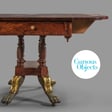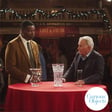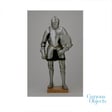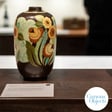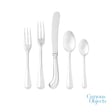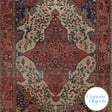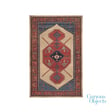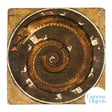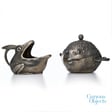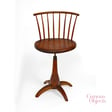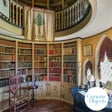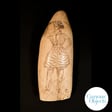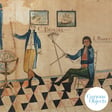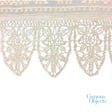Become a Creator today!Start creating today - Share your story with the world!
Start for free
00:00:00
00:00:01

135,500 Pieces (Of Wood)
In this episode, the fine line between obsession and madness, illustrated in a piece of furniture. Toledo Museum of Art curator Erin Corrales-Diaz joins Ben to discuss a unique secretary desk which might hold the world record for inlay: thousands upon thousands of pieces of wood, which in its maker’s own words, “will do more in ten minutes to inspire young people with the possibilities of life than ten years of haphazard and scattered endeavor.
Transcript
Introduction to 'Curious Objects'
00:00:11
Speaker
Hello, and welcome to Curious Objects, brought to you by the magazine Antiques. i'm Ben Miller. This is the podcast about art, decorative arts, and antiques, the stories behind them, and what they can reveal to us about ourselves and the people who came before us.
Feature on Unique Object from Ripley's
00:00:25
Speaker
now Can you believe that this is the first Curious Objects episode ever with an object that was actually featured in Ripley's Believe It or Not? Believe it or not, it's true. Our Curious Object for today is a truly extraordinary example of obsession.
00:00:41
Speaker
And maybe, I don't know, we'll talk about this, but maybe mental instability. ah This is a secretary desk that, if you're a close follower of the Americana Week sales in New York, you might've seen this come across the block at Christie's.
00:00:55
Speaker
but which going forward you'll be able to see in Toledo, Ohio.
Interview with Erin Corrales-Diaz
00:01:00
Speaker
And my guest is Erin Corrales-Diaz. She's the curator of American art at the Toledo Museum of Art.
00:01:08
Speaker
And Erin, I really cannot wait to pick your brain about this amazing piece, which, by the way, listeners should absolutely go right now to the magazineantiques.com slash podcast and look at images of this incredible thing.
00:01:22
Speaker
But Before we get to all that, are you ready, Erin, for some rapid fire questions? Let's do it. I'm i'm so excited. Yes, that's a brave face you're putting on.
00:01:36
Speaker
What is a simple everyday object that you find to be a masterpiece of design? oh My Chemex. Yes, I feel the same way. It's just, it works so well.
00:01:48
Speaker
It does. It's so simple, clean lines, great cup of coffee. Okay, well, speaking of clean lines, you have to decorate your home with only one of these for the rest of your life. Minimalism or maximalism?
00:02:02
Speaker
Which is it going to be? Oh, gosh, that is such a hard question. i know, it's a Sophie's choice. It is, it is.
Erin's Top Pick to Save from an Asteroid
00:02:10
Speaker
You know... I was swayed a bit by minimalism of late and now have really started to shift a bit more towards something a little more maximalistic, which kind of aligns with our objects.
00:02:26
Speaker
It very much does, which is exactly why I asked the question. Okay. There's an asteroid headed for earth. You of course are on the escape pod. What one object or artwork are you bringing?
00:02:40
Speaker
oh man This is like an even harder question. It's the only aesthetic relic of human civilization that will survive the apocalypse, and you get to choose it. No pressure.
00:02:51
Speaker
and No pressure. um I'm being really Toledo-centric here, but I do firmly believe this. We have what's known as the Libby Punchbowl that was made in 1904, and it is an amazing work of cut glass, and it weighs about 143 pounds. And when you put it in the galleries and you lamp it the right way,
00:03:13
Speaker
it sparkles. I love it. So that'll be a nice little, uh, little bit of light for your long, dark journey through the void. Totally.
Engaging the Audience
00:03:23
Speaker
Okay, what is the best bargain that you've ever scored on an antique?
00:03:28
Speaker
It would probably be a stereo card that I picked up of, um... ah Hiram Powers sculpture.
00:03:38
Speaker
I think it was just a couple of bucks in and antique mall in Port Angeles, Washington, and I was really excited to find it. Nice. Where do you keep it? I keep it on a bookcase, actually.
00:03:53
Speaker
What is the most fun that you've ever had doing research for an acquisition? I mean, this one really sort of takes the cake, the Eberhardt secretary. And part of that's because there's so much primary source material about it in the local papers. um And as an avid researcher, I really loved delving into that and hearing...
00:04:18
Speaker
reading about the object from the artist's own words. So yeah, that it's hard to compete with that. What, what's a craft or a craft related skill that people often dismiss, but that you consider to be a form of high art?
00:04:36
Speaker
I would say anything fiber related. So whether that's knitting, crochet, even macrame, embroidery, needlepoint, I think any of those forms require extensive skill.
00:04:53
Speaker
i And i think have, you know, really historically been dismissed. So... Yeah, that's a line that I've often preached on Curious Objects, actually. A lot of textile episodes.
00:05:04
Speaker
Yeah, agreed. If you could secretly deaccession one famous artwork, that not just from Toledo, but from any museum, what would it ah what would you get rid of? Hot take?
00:05:17
Speaker
um It would probably be any of Renoir's later nudes. Wow. I'm just not a fan. Okay, shots fired.
00:05:28
Speaker
I know, oh gosh. Now, by contrast, what's an object that you think is truly priceless, but that has very little market value? It would be the punch bowl.
00:05:38
Speaker
i This is, it's it's very Toledo-centric. um You know, it's cut glass. The market for that, you know, isn't really extensive. But for us, it's truly something that's priceless.
00:05:54
Speaker
All right, well, we will be right back with Aaron Corrales-Diaz. As always, I want to take just a very quick minute to say thank you for joining me, and thanks for getting in touch and sharing your thoughts.
00:06:07
Speaker
ah You can email me at CuriousObjectsPodcast at gmail.com, or find me on Instagram at ObjectiveInterest. I always love hearing your feedback, your comments, your corrections. I do actually enjoy those, believe it or not.
00:06:23
Speaker
And of course, your your ideas for future episodes. So please keep those rolling in. All of you who take the time to listen and maybe hopefully learn a few things about these objects and and join me in connecting to their stories.
00:06:39
Speaker
You are the reason that we do this show. So thank you for tuning in. Thank you for subscribing to Curious Objects in your podcast app. If you haven't done that yet, do it now. That is the best way to make sure you don't miss future episodes.
00:06:55
Speaker
All of that will take no more than one or two minutes, but it really helps me out and the team. So thank you so much for doing it.
The Marvel of the Secretary Desk
00:07:06
Speaker
All right. Now, Aaron, we've got something really amazing to talk about today, and I hope that listeners are looking at pictures, whether it's in their podcast app or on the internet right now. But just describe for me, if you possibly can, and I know this is a tall order, but describe to me what this piece looks like.
00:07:25
Speaker
All right, so it is, it's a secretary. um it is a combination desk and bookcase. It's, I think it is worth mentioning sort of the dimensions, even though that can be kind of hard to visualize. It's eight feet tall, four feet wide, 22 and a half inches deep, and reputedly weighs about 800 Wow. So it's the size of a small car. Exactly. Exactly. Luckily for our art handlers, it does come apart into two pieces. um It is completely covered with marquetry.
00:08:04
Speaker
I mean, completely covered. This is an example of like, or a back wheat, right? It's just every sort of surface is covered with marquetry. a lot of geometric patterns, um and then iconography related to the US as well.
00:08:22
Speaker
Yeah. So the, I mean, the the overall visual impression is just of incredible intricacy and complexity. And so you you said marquetry. Can you just explain to all of us so what the difference is between parquetry and marquetry and inlay and all of that business? Yeah. Yeah, I mean, like I obviously not as a a woodworker. So um for those of you who are, sure generalizing for for a general audience. yes please. Marquetry is a technique where you're using ah different wood veneers.
00:09:00
Speaker
yeah So very thin sheets of wood that are then put together like a jigsaw puzzle and adhere to a wood substrate. And parquetry is the same technique, essentially, um and only it's more about sort of that geometric patterning. And it's typically something that you would find like on your floors, sort of hardwood floors that would have intricate designs that would be more of parquetry.
00:09:29
Speaker
So this is a a piece that has both of those examples. All of it would have been done by hand. Like this is the era before power tools, right? So it's just something to sort of keep in mind as you're looking at the object um ah of the craftsmanship that it would take to sort of cut all of these small slivers of wood.
00:09:52
Speaker
Yeah, so let's let's get into the statistics a little, because it's really incredible. I have read that there are 135,511 pieces of wood on this piece, ah representing 537 species of wood. I'm and trying to keep this family-friendly, so I'm not going to express my true feelings about that right now, but oh my god.
00:10:17
Speaker
i mean, how do you... How do you, as a curator, how do you even begin to analyze something that incredibly complex? Right. The other thing that's just to mention as terms of a fact check on the back. So we know the number of how many sort of types of wood and the number of pieces, as well as how long it took Eberhardt, the artist, to make it because there is an inscription on the back.
00:10:44
Speaker
How nice, how kind is that, right, for for his future curators? 135,341 pieces. ah one hundred and thirty five thousand three hundred and forty one pieces Oh, sorry, i was by now i have not counted these by hand so we are taking iberhart at his word here And it took him three years and eight months to create this, right?
00:11:09
Speaker
One of the things that's also really extraordinary about the piece, and I'm, as a researcher, I'm still in the early stages here on sort of unpacking everything that we can, all the different directions that we can take this object.
00:11:23
Speaker
ah is that we have a lot of the ephemera, the letters that were sent to Eberhard. We have a number of his patterns that he made and that he recorded all the different types of wood and where they went.
00:11:40
Speaker
So this is a a project that I hope in the future to actually work with our conservation team on and to do some really serious wood analyses, because he's saying there's over 357 different types of wood from around the globe.
00:11:55
Speaker
Wow. I mean, I just have difficulty wrapping my head around the fabrication process. yeah And I want to talk about about Yuria um in just a minute. But before we get to him, to to his sort of fascinating biography,
00:12:10
Speaker
I want to talk about your encounter with this piece and your colleagues' encounter with this piece because, you know, as I mentioned, this came up for sale at Christie's and so it was coming up for public auction. So this isn't something that a private donor decided to bequest to the museum.
00:12:27
Speaker
This isn't you know just something that fell into your lap. This is a piece that you guys had to decide actively that you were going to pursue. And you had to decide how much you were willing to try to to to bid to try to buy it.
00:12:41
Speaker
And then you had to sit on the edge of your seat and watch that auction actually happen. So I want to hear about the you know the internal behind the scenes experience from your perspective. What was that process like?
00:12:54
Speaker
That's a really great question. Hopefully sort of demystifies some of the process of acquisitions and auctions for the listeners. um So my purview covers American art, which includes painting, sculpture, but also the decorative arts and works on paper. And as I was doing a collecting acquisition strategy, I realized furniture is an area where we do not have a lot of depth in.
00:13:18
Speaker
Very few pieces, let alone anything from Ohio. So this is the very first piece of Ohio furniture in our collection. So I i sort of had an eye out for it and of course always actively look at the Americana Week sales. um And i I saw this and immediately thought, this is something truly extraordinary. It's accessible to the public.
00:13:46
Speaker
It was made by someone who was self-taught. It's from North Central Ohio. You know, it it seemed to hit all of the marks that we were looking for. So I pitched this internally and to our to our team.
00:13:59
Speaker
which is part of our process and that went over swimmingly. And so then we had to do the process of sort registering for the auction and our deputy director was on the phone for the bid.
00:14:14
Speaker
um Of course, in advance of all of this, um I went and had an opportunity to see it in person. We had our conservator actually come and take a look at it as well ah to sort of just ensure that everything was was was correct and What we did during the auction, because it's live streamed on Christie's, was send it to the rest of our staff and let anyone just sort of join in while our deputy director was bidding.
00:14:46
Speaker
And some of our internal staff, like, you know, they booked up some of our conference rooms and live streamed this and our team's chat. was on fire, you know?
00:14:58
Speaker
And so everybody got extremely excited then when we were successful and they saw our boss jump out of her chair and was just like, this is now ours. So it's um it was an opportunity for everybody from different departments not just curatorial, to be engaged in the acquisition process and to feel like a sense of, yeah, being a part of that, a sense of ownership in that way. So we were really excited when we finally, when it finally came from New York.
00:15:30
Speaker
I mean, so first first of all, I just love the idea of an auction watch party, and I think I'm going to steal that. i yeah And then also, by the way, i think listeners might be interested to know that um the person at Christie's bidding on your behalf was actually a former Curious Objects guest and also recent guest editor of Antiques magazine, Kara Zimmerman.
00:15:52
Speaker
So yeah, it's ah it's a small, friendly, usually friendly world. Okay, so this piece arrives. And by the way, how did you have it shipped? Because 800 pounds with those dimensions, that's not trivial, right? Right. So it does come apart.
00:16:08
Speaker
that was That was the first question our art handlers asked. was just like, is this going to be one enormous Christmas? Um, so no, it was, it was the, the desk, the lower half, and then there's an upper half. And so they were, there are two crates that made it a lot, a lot easier to, to get it shipped.
00:16:27
Speaker
And that makes me sort of think about the process of making it because, so you've alluded to this, but the fellow who made it, Juria Eberhardt, he is, you know, often on curious objects.
Eberhardt's Inspiration and Craftsmanship
00:16:40
Speaker
We're talking about the very famous world-class artisans, you know, people who who have incredibly rich, deep reputations as the most refined and sophisticated makers of their day.
00:16:51
Speaker
This is almost exactly the opposite. I mean, this really is a piece of folk art, or at least ah of self-taught art, right? And so I'm picturing a garage with, you know, and I, for the record, i don't know anything about Yuri's private life, personal life, but I'm just picturing his wife furious that he is just filling the house with thousands and thousands of pieces of wood.
00:17:15
Speaker
And there's sawdust covering everything. And he is, and for for four years, she can't live a normal life. And Yuri is just, you know, he is monomaniacally focused on this task.
00:17:27
Speaker
I mean, that's crazy. This is a crazy hobby, right? i mean, am I right about that? i And it's a hobby that then eventually turns into his profession.
00:17:38
Speaker
Yeah, I love the picture that you painted for us. i We really have no idea sort of that sort of inner family dynamics or sort of the the workshop aspect of this. But ah Yuri Eberhardt was not artistically trained. He was totally self-taught. He was a barber before this.
00:18:02
Speaker
He spent about... a decade and a half as a barber in Savannah, Ohio, so north central Ohio. And what time period are are we talking about, by the way? So he's in Savannah, Ohio, and he moves there in 1886. And again, he's sort of in this particular trade for about a decade and a half.
00:18:22
Speaker
It's in 1893, when we have this sort of moment of inspiration, say. He goes to Chicago. Like many Americans at this particular moment, he goes to the World's Fair.
00:18:37
Speaker
And while he's there, he sees inlaid furniture from gu Guatemala. And he basically says, i want to do this and decides I'm going to take up marquetry.
00:18:50
Speaker
You know, he wants to essentially paint with wood. This is what he wants to do. So he didn't teach this himself. He starts with like small wooden blocks making marquetry patterns.
00:19:03
Speaker
And then progresses to a bedroom suite and a few other small pieces of furniture. So Yuri's wife had to deal with this much longer than three years and eight months of him working keen on the secretary.
00:19:16
Speaker
ah But then in November 17th, 1896 is when he starts working on this, this particular piece, this work is, He talks about it as his masterpiece, that he wanted to do something the likes that had never been seen before and totally worthy of a museum.
00:19:35
Speaker
Where he got the idea to start soliciting wood fragments from around the world, I'm not really sure what sort of prompted that, but But what he does is he starts using his network. ah He's deeply religious, so he's connected with various missionaries through throughout the world.
00:19:55
Speaker
And asks anybody, do you have some wood fragments from where you are? Do you have some wood fragments? And people respond in droves. Again, we have stacks upon stacks of these letters documenting and indicating the type of wood.
00:20:12
Speaker
um But what was really interesting is that a lot of these individuals then began sending Eberhardt pieces of wood that have some sort of a historical connection so now are we collecting wood fragments from around the world but we have reputedly wood fragments that are from various military endeavors have connections to political figures
00:20:43
Speaker
There's supposedly ah fragment from Lincoln's boyhood home in Illinois, um ah piece of black walnut from a tree that was struck by a bullet at Gettysburg, part of Benjamin Harris's fence.
00:20:59
Speaker
Again, these are not verified, but the idea of the fact that in the late 19th century, people were... holding onto these objects as souvenirs, as relics, and getting great sort of power and nostalgia and national memory from these, and then giving them up to this man in North Central Ohio to be a part of this secretary. I mean, he must have been incredibly convincing.
00:21:29
Speaker
and In fact, yeah we've even previously had a Curious Objects episode on that topic with Ellery Fouch and a reliquary chair made by Henry Sheldon. and You can go back further than that. i mean You have, for example, pieces of the Bascobel oak that are worked into 17th century pieces in England.
00:21:51
Speaker
I mean, you went well, I don't know, you could talk about pieces of the true cross, right? So the idea of using sentimentally significant wood as part of a new project is an old one.
00:22:03
Speaker
So I suppose Yuri could have presumably gotten that from a lot of places, but then he took it into this completely different level, right? And we have logbooks. I mean, the man was a major record keeper,
00:22:20
Speaker
Ph.D.: the fact that we have the patterns for all of the the block like designs they're kind of akin to like a quilt block those have ah about there's about 40 of them that contain both fruits and animals, but what's really interesting are the.
00:22:41
Speaker
Wood from all of the states in the Union. So in 1900, that would be 45 different states and then 31 different territories. So like the Hawaiian Islands and then other foreign countries as well.
00:22:55
Speaker
And he would really tailored the type of woods to those particular areas. So for Ohio, for instance, and again, we've got we've got the pattern and he has carefully identified for us each little fragment as to which type of wood it is.
00:23:12
Speaker
There are buckeye and pawpaw trees for Ohio. So things that are very distinct ah and native to the region, which is also really extraordinary.
00:23:23
Speaker
Yeah, and so I'm curious. I mean, so he's devoting now years and years of his life to this passion project. He says that he wants to make something that's worthy of a museum, but did he have a ah vision for what he really wanted to do with it?
00:23:40
Speaker
I mean, was it something he wanted to sell or something he wanted to keep and use for himself? Or do do we have a sense of that? a little bit um and i think more that will come to light as we continue to go through all of the papers that he kept but he made postcards of the secretary he did travel it sort of throughout so and which was then written up in various papers that this object was coming
00:24:10
Speaker
And he did say in a newspaper article that looking upon the secretary, it will do more in 10 minutes to inspire young people with the possibilities of life than 10 years of haphazard and scattered endeavors.
00:24:26
Speaker
Wow. So he had very high aspirations for what this particular secretary could do. I do know towards the end of his life, he did want it to be in a museum. yeah And it that just never quite panned out.
00:24:43
Speaker
Right, because where did it go instead? So it was passed down through the family, and it was the grandchildren that then finally decided, you know, maybe it's time to put this on the market.
00:24:56
Speaker
And it was sold at Sotheby's in 2002, where it then went into the collection of Marjorie and Robert Hirshhorn, who had a collection of American folk marquetry. Right, but in between, I mean, it really had quite a life through the course of the 20th century, yeah including, as I teased at the start, Ripley's Believe It or Not, which is just incredible to me, and I hope you can tell me something about that.
00:25:20
Speaker
Yeah. Exactly. it was, it's the only documented like exhibition that we have is the Ripley's Believe It or Not Auditorium. um It was supposed to be in a World's Fair in New York.
00:25:35
Speaker
It never quite manifested and we're not really sure why. Again, still some research to be done on that. But it was really just ah a man with a vision who was,
00:25:48
Speaker
finding ways to disseminate what he had created, which When you look at the primary source material, i mean, this was an entire box filled with these letters and then newspaper clippings and the postcards um that, yeah, he was this this sort of entrepreneur with a vision and he wanted to share, you know, he was he was so active in that regard.
00:26:19
Speaker
Yeah, so what so ah pardon me for really sticking to this point, but Ripley's is you know I think of Ripley's today as you know a circus sideshow but kind of thing where you I don't know you stick your hand into the mystery barrel and you feel something disgusting inside or you know you see amusement park style attractions but this is something very very different right I mean It's an exhibition of American craftsmanship.
00:26:47
Speaker
So how does that fit in with Ripley? I mean, that did Ripley used to be something completely different than it is today and they were really showing off, you know, art? Or what what? How would a piece like this end up in that context? You know, yeah i got to say, we still we still have some research to do on that. So I can't quite sort of give the the full background.
00:27:10
Speaker
But I guarantee you when we do know, we will we will certainly publish that as a label on our website. Yeah, well, let me know about that, because I'm super curious. So once this piece arrives in Toledo and you finally have a chance to, I mean, you you had seen it in person in New York, but now you have a chance to really spend time with it and, you know, get into the weeds.
00:27:31
Speaker
And was there something about it, anything that surprised you, that caught you off guard, that you hadn't seen or noticed before? eight You know, it's, i I'm excited to spend some more time with this iconography.
00:27:45
Speaker
Right, to really unpack what all of these symbols are, because he was so intentional with what he selected. And it's pretty apparent with the blocks that represent sort of the US states or the various countries, um what what those are meant to be. And he and also inscribes the states.
00:28:07
Speaker
ah with each block. So again, we can very clearly identify each of these. um But it I'm really taken with some of the iconography of the religious and fraternal organizations. They are all over this entire piece.
00:28:27
Speaker
um And so that's taking a little bit of time to kind of unpack. And there's the
00:28:35
Speaker
organizations that you'd expect at this particular moment so like the freemasons and the odd fellows but there's also ah the macabees the epworth league the modern woodmen of america things that are a little more niche and sort of how those connections came to be and whether if eberhardt was a member of all of these or what kind of prompted this like display of a golden age of fraternal organizations and And one of the things that I found so unusual about the piece that, you know, when I saw it in person and was considering acquiring it, is the fact that we also had the self-portrait of the artist.
00:29:14
Speaker
So in the finials, on the right side, it is Eberhard, and then on the left, it is his wife. Which is pretty extraordinary. I can't, I mean, not only did he like inscribe when he started and ended this, how many different types of wood, how many different pieces of wood, but he also included an image of himself um um on this particular object that is meant to be so inspirational.
00:29:39
Speaker
Yeah, well, it's, I mean, you could hardly blame him. He's spent four years working on the thing. it think like Exactly, exactly. i'm But in terms of like research moving forward and things that I'm excited about, i i do think this is a partnership project with our conservation department is to really think about properly identifying all the wood.
00:30:03
Speaker
Sarah Mastrianni, And then ah substrate as well and then to really sort of piece together what happens sort of to the object more ah once he completes it.
00:30:27
Speaker
You know, we have a lot of these reports that it was sort of traveling throughout, it ends up at, really please believe it or not, but we need to sort of go through those particular papers and to really trace out this timeline of the object's biography. And those are things that I'm really excited about delving into.
00:30:44
Speaker
So is it on view yet in the museum?
Future Exhibition Plans
00:30:47
Speaker
So it is not yet on view. will be unveiled in fall of 2027, which is when we are meant to reopen our museum.
00:31:00
Speaker
ah Parts of it are closed at the moment because we're embarking on a major reinstallation project, something that is emphasizing global cross-cultural and a chronological approach. And so an object like this, I couldn't believe that it's Ohio made, so it has that local connection, but with all of the wood fragments and the story about being inspired by the World's Fair, you also have a global object as well.
00:31:26
Speaker
Yeah, I mean, it sounds like it's sort of perfectly tailored for this concept, ah for the reinstallation. Does it, mean, are there some sort of obvious ways for it to communicate with other objects in the collection?
00:31:38
Speaker
Yeah, actually, we have another extraordinary work of marquetry that's European, Joseph Krummer, and we have one of his his cabinets that also have sort of these international sort of World's Fair connections.
00:31:53
Speaker
And it would be great to sort of pair the two of them to talk about the craft of marquetry in these international contexts and how that translates sort of over time.
00:32:05
Speaker
So looking forward to 2027, when this piece is presumably out in public view and thousands of listen thousand ands of listeners, hopefully thousands of listeners, but definitely thousands of visitors will be traipsing through the gallery and looking at this piece.
00:32:21
Speaker
what's um What's one detail that you would encourage people to seek out as they're as they're looking at it? Well, it might be hard to see from the images, but... this secretary presents a very solid front.
00:32:35
Speaker
There's no knobs, there's no handles, but things do open. There are sort of secret springs that you can press. Now I'm not saying for our visitors to come up and to do that, but to see if you can sort of visualize and note, you know, where, where those might actually be embedded into the work.
00:32:56
Speaker
um it's ah It's a fun surprise that we had. and we're definitely thinking about various ways in which we can bring some of the patterns into the gallery as well. So people can then see the pattern, see the different ah notations about the types of wood, and then actually look.
00:33:20
Speaker
at the object. But I would certainly call attention for visitors to take a look at the portraits of the artist and his wife. I mean, I think those are really extraordinary. I've never seen anything quite like that before.
00:33:34
Speaker
Fabulous. Well, I can't wait now. I've got something to look forward to in a couple of years. And I hope you'll keep us posted on the evolution of the research and your understanding of the the context around this piece and around Yuria himself.
00:33:47
Speaker
Absolutely. Erin Kralis-Dias, thank you so much for talking with me today and sharing this story with our listeners. Well, thank you so much for having me.
00:33:59
Speaker
Today's episode was edited by Julian Minerva. Support from the Magazine Antiques editorial team includes senior editor Sarah Stafford-Turner, managing editor Christine Hildebrand, and editorial assistant Irvashilele.
